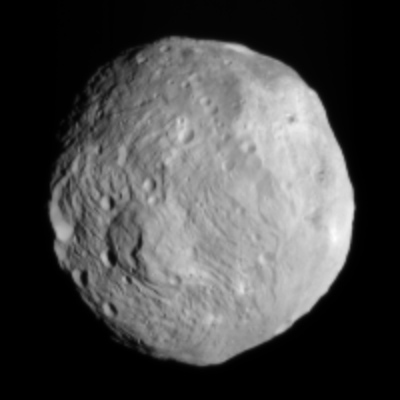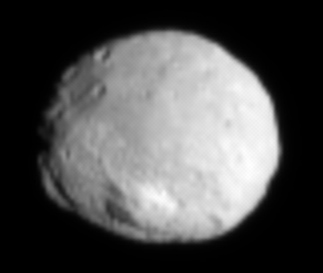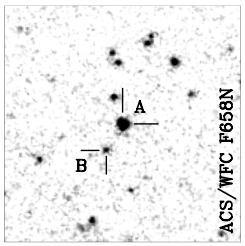Dawn enters orbit around Vesta
Dawn enters orbit around Vesta.
Dawn enters orbit around Vesta.
Dawn enters orbit around Vesta.
A new analysis of the orbits of Ceres and Vesta says that in a surprisingly short time those orbits become chaotic and therefore unpredictable. More significantly, those orbits interact with the Earth’s and also make its long term orbit chaotic and unpredictable. From the abstract:
Although small, Ceres and Vesta gravitationally interact together and with the other planets of the Solar System. Because of these interactions, they are continuously pulled or pushed slightly out of their initial orbit. Calculations show that, after some time, these effects do not average out. Consequently, the bodies leave their initial orbits and, more importantly, their orbits are chaotic, meaning that we cannot predict their positions. The two bodies also have a significant probability of impacting each other, estimated at 0.2% per billion year. Last but not least, Ceres and Vesta gravitationally interact with the Earth, whose orbit also becomes unpredictable after only 60 million years. This means that the Earth’s eccentricity, which affects the large climatic variations on its surface, cannot be traced back more than 60 million years ago. This is indeed bad news for Paleoclimate studies. [emphasis mine]
The scientists found that it became impossible to calculate the orbits of the two largest asteroids after only several ten thousand years. They also found that “numerous asteroids in the main belt will behave in the same way with . . . much more chaotic behavior than previously thought.” Worse, the possibility of collisions was far higher than ever thought. Ceres and Vesta have a 1 in 500 chance of colliding with each other every billion years, while other asteroids have chances as low as 1 in 1000.
The importance of this discovery, which still needs to be confirmed by other researchers, cannot be understated.
» Read more

Another image of Vesta from Dawn has been released. This image was taken on July 9 from a distance of 26,000 miles away. It is definitely an improvement over the previous image, with more small details becoming visible. However, I once again wonder about the softness of the image. Look at the limb of the planet. It is soft against the black sky. This is not what one would expect from perfectly focused camera.
Dawn goes into orbit around Vesta next week. We sure learn then for sure if there is a problem with its camera, or whether I am merely being a bit too nervous.
Astronomers have found two new brown dwarf stars only 15 and 18 light years away.
Most brown dwarfs have reached surface temperatures below the “oven temperature” of about 500 Kelvin (about 230 degrees Celsius), may be even as cool as the temperature at the surface of the Earth. The search for these elusive neighbours of the Sun is currently in full swing. It cannot be excluded that ultracool brown dwarfs surround us in similar high numbers as stars and that our nearest known neighbour will soon be a brown dwarf rather than Proxima Centauri.
White dwarf stars in a dance of death.
[The binary pair of] white dwarfs are so near they make a complete orbit in just 13 minutes, but they are gradually slipping closer together. About 900,000 years from now – a blink of an eye in astronomical time – they will merge and possibly explode as a supernova. By watching the stars converge, scientists will test both Einstein’s general theory of relativity and the origin of some peculiar supernovae.
The two white dwarfs are circling at a bracing speed of 370 miles per second (600 km/s), or 180 times faster than the fastest jet on Earth. “I nearly fell out of my chair at the telescope when I saw one star change its speed by a staggering 750 miles per second in just a few minutes,” said Smithsonian astronomer Warren Brown, lead author of the paper reporting the find.
The brighter white dwarf contains about a quarter of the Sun’s mass compacted into a Neptune-sized ball, while its companion has more than half the mass of the Sun and is Earth-sized. A penny made of this white dwarf’s material would weigh about 1,000 pounds on Earth. Their mutual gravitational pull is so strong that it deforms the lower-mass star by three percent. If the Earth bulged by the same amount, we would have tides 120 miles high. [emphasis mine]
I’ve posted earlier about Dawn’s approach to Vesta. However, in looking at the images from Dawn, it dawned on me recently that they seems more fuzzy for what you’d normally expect from a space probe. I am now wondering if there is something fundamentally wrong with Dawn’s camera, causing its images to be slightly out of focus.
Neptune has just completed its first orbit around the sun since its discovery in 1846. And the Hubble Space Telescope has taken some pictures in celebration.
A paper published today on the Los Alamos astro-ph preprint website has attempted to model the habitable zones within the Milky Way galaxy. From the abstract:
We predict that ~1.2% of all stars host a planet that may have been capable of supporting complex life at some point in the history of the Galaxy. Of those stars with a habitable planet, ~75% of planets are predicted to be in a tidally locked configuration with their host star. The majority of these planets that may support complex life are found towards the inner Galaxy, distributed within, and significantly above and below, the Galactic midplane.[emphasis mine]
They took into consideration the hazard of supernovae for killing off planetary life, as well as other factors such as the where the necessary heavier elements would be available for producing planets.
You can download the paper here [pdf].
Dawn continues to approach the large asteroid Vesta. Below is an image taken July 1st from about 62,000 miles. The image has a resolution of 5.8 miles per pixel.
Despite Vesta’s large size, 330 miles in diameter, it is nonspherical. This fact, combined with data that says it is differentiated with a core and mantle, suggests that it is the remains of a larger object that subsequently broke up.

A serious coolant leak has put the Subaru Telescope in Hawaii out of commission.
More delays for the James Webb Space Telescope?
Mysterious bubble of light, caused by military suborbital rocket, captured by Hawaii telescopes.
Astronomers have found the most distant quasar ever, and are baffled by its existence.
The light from the quasar started its journey toward us when the universe was only 6% of its present age, a mere 770 million years after the Big Bang, at a redshift of about 7.1 [3]. “This gives astronomers a headache,” says lead author Daniel Mortlock, from Imperial College London. “It’s difficult to understand how a black hole a billion times more massive than the Sun can have grown so early in the history of the universe. It’s like rolling a snowball down the hill and suddenly you find that it’s 20 feet across!”
Want to send a probe to another planet? Do it cheaply, as these scientists did.
Cassini has directly sampled the plumes from Enceladus and discovered a salty ocean-like spray.
The new paper analyzes three Enceladus flybys in 2008 and 2009 with the same instrument, focusing on the composition of freshly ejected plume grains. The icy particles hit the detector target at speeds between 15,000 and 39,000 mph (23,000 and 63,000 kilometers per hour), vaporizing instantly. Electrical fields inside the cosmic dust analyzer separated the various constituents of the impact cloud.
The data suggest a layer of water between the moon’s rocky core and its icy mantle, possibly as deep as about 50 miles (80 kilometers) beneath the surface. As this water washes against the rocks, it dissolves salt compounds and rises through fractures in the overlying ice to form reserves nearer the surface. If the outermost layer cracks open, the decrease in pressure from these reserves to space causes a plume to shoot out. Roughly 400 pounds (200 kilograms) of water vapor is lost every second in the plumes, with smaller amounts being lost as ice grains. The team calculates the water reserves must have large evaporating surfaces, or they would freeze easily and stop the plumes.
Citizen astronomers: Help pick the Kuiper Belt targets that New Horizons will visit after it flies past Pluto.
The Roman emperor Hadrian built his country estate with the buildings aligned with the sun.
For centuries, scholars have thought that the more than 30 buildings at Hadrian’s palatial country estate were oriented more or less randomly. But De Franceschini says that during the summer solstice, blades of light pierce two of the villa’s buildings.
In one, the Roccabruna, light from the summer solstice enters through a wedge-shaped slot above the door and illuminates a niche on the opposite side of the interior (see image). And in a temple of the Accademia building, De Franceschini has found that sunlight passes through a series of doors during both the winter and summer solstices.
The Pan-STARRS Telescope has found a comet that might provide us all a show in 2013.
An X-ray deep field image taken over a six week period by Chandra had found that massive black holes are common in early universe.
These results imply that between 30% and 100% of the distant galaxies contain growing supermassive black holes. Extrapolating these results from the relatively small field of view that was observed to the full sky, there are at least 30 million supermassive black holes in the early Universe. This is a factor of 10,000 larger than the estimated number of quasars in the early Universe.

The progenitor star that produced the May supernovae in the Whirlpool Galaxy (also known as M51) has been identified, and it isn’t what scientists predicted.
In a preprint paper published today on the Los Alamos astro-ph website, astronomers describe the star that exploded as a yellow supergiant, not a red supergiant or Wolf-Rayet star, as predicted by the theory explaining this particular type of supernova. Moreover, though theory also favors the star being a member of a binary system, the progenitor of 2011dh appears to be a lone star, not even a member of a cluster.
» Read more
Europe has decided to shrink the design of the gigantic Extremely Large Telescope (yes, that’s really its name) by 13% to save money.
A galaxy with two central supermassive black holes.
Magnetic bubbles at the edge of the solar system.
This week the Space Telescope Science Institute in Baltimore, Maryland was holding a conference on the future research possibilities of the James Webb Space Telescope, and ended the conference with a writer’s workshop/press conference today.
Not surprisingly, there was not a lot of press interest. The Webb telescope is way behind schedule and over budget, and is not scheduled for launch until 2018. For most of the press, a press conference now on what Webb might someday do is really nothing more than a NASA sales pitch. Most reporters, including myself, don’t find these kinds of press conferences of much worth.
However, after thinking about it a bit, I decided to go, with the hope that I might be able to find out some more details about the state of the telescope’s construction.
To my astonishment, I discovered how little press interest there was, as it turned out I was the only journalist there! When the presentations ended, the whole workshop became an exercise in answering Bob Zimmerman’s questions about Webb and astronomy. I felt a bit embarrassed about this, but then decided the only stupid question is the one you don’t ask, and forged ahead. Moreover, the situation probably was far more embarrassing for the press people at the Institute then it was for me.
» Read more
The remnant of supernova 1987a lights up.
This supernova is the only naked eye supernova since the invention of the telescope, and has been tracked by Hubble for two decades.
An evening pause: a beautiful simulation of galaxy collision. Hat tip: Sky and Telescope.
A new supernova has erupted in the nearby galaxy M51, 23 million light years away.